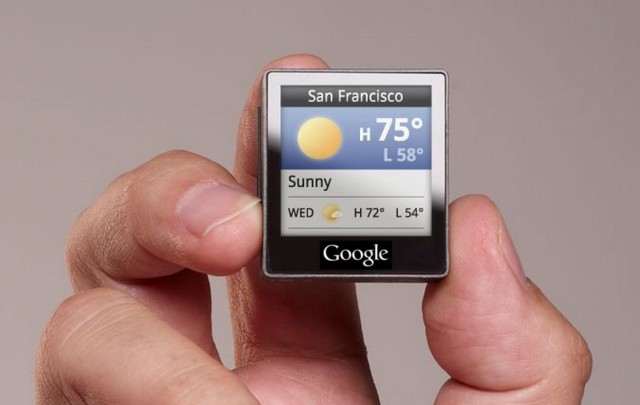Google’s Smartwatch Won’t Be a Smartwatch
Between now and Christmas, we’re going to see a flood of new smartwatches hitting the market, and I have the feeling that Google’s rumored smartwatch will be one of them.
Google is working on a smartwatch. But what kind of watch?
In the wake of revelations that Google bought WiMM Labs, it’s looking like Google’s smartwatch may be more than just a watch. Much more.
Google secretly acquired Silicon Valley-based, Foxconn-backed WiMM Labs more than a year ago, then shut the company down.
That means Google has been doing whatever it is they’re planning to do with WiMM people, technologies and products for more than a year. So what have they been doing?
WiMM had at least two patents: This one and this one.
At the time WiMM vanished into Google, the company was hawking a one-year-old smartwatch called the WiMM One, a blocky, $199 Android computer about an inch and a half high, an inch and a third wide and a half-inch thick. It weighed just over three-quarters of an ounce and was powered by a 667-MHz ARM11 CPU, 256 MB of RAM, up to 32 GB of storage and a 30-hour battery. The capacitive touch screen was 160×160. It connected via Bluetooth 2.1 and WiFi, and supported USB 2.0. Inside the device was an accelerometer and a compass.
In short, the WiMM One was like a low-powered Android phone crammed into a tiny box with three key differences: 1) no electronics for making calls; and 2) an SDK to create “micro apps” for the unusual screen size; and 3) “seamless” integration with not only Android devices, but also iOS and Blackberry devices, too.
The developer materials also set up a system where users could manage settings in the cloud, rather than on the device. WiMM, in fact, had adopted the Platform as a Service (PaaS) model in which the user browses, adds, deletes and configures apps on the web, which then show up on the device. Just like Google Glass does.
The WiMM One had some interesting power management. For starters, and unlike other smartwatches we know about, the screen remains lit all the time until you turn the device off, refreshing with updated information only once per minute, allowing what a company press release called “useful, subtle glances.” This low power mode displays 4-bit grayscale using ambient light unless awakened into full-power mode, in which it displays back-lit 16-bit color — an approach that sorta, kinda reminds me of the Moto X’s approach to power management through switching between regular mode and ultra-low power mode.
If you look at WiMM’s old videos, they strongly emphasized that it was all about platform and was designed for maximum versatility to be determined by app and aftermarket hardware makers. Specifically, they show WiMM used as a clip-on “digital companion” productivity computer, a “health advisor” sports computer, a “personal assistant” wristwatch, an “electronic wallet” necklace and a bike-mounted “performance monitor.” The videos also say both the hardware and software are “open.
Initially, according to at least one report, WiMM set out initially to develop a wearable computer more like Google Glass, but switched to a watchable format later. Ultimately, however, the hardware was sold so developers and hardware hackers could create stuff for it. And they did.
Surprising fact: The WIMM app store is still publicly available here and a “companion app” here.
Google has another acquisition with contributions to make to its smartwatch. Namely, Motorola.
That company has patents and technology related to its MOTO ACTV fitness tracker wristwatch, which is a pretty good fitness watch and a so-so smartwatch. It does, however, have some power management technology that Motorola used in the Moto X.
So you can imagine Google’s watch may add biometric sensors for fitness, and also have better battery life than the WiMM One.
Most of all, however, Google has Google stuff to boost the watch.
For starters, many of the technologies and ideas for Google Glass would be fantastic in a smartwatch or all-purpose wearable computer, especially the whole cards-based interface in general and the Google Glass interface in particular. (In fact, the WiMM interface was already card-like and Google Glass-like when Google bought the company a year ago.)
Google Glass is killer in part because it’s Google Now centric, as Google’s watch should be.
Putting together all these resources, adding a shot of speculation and shaking vigorously, it’s easy to imaging Google’s iWatch killer.
While the Apple iWatch will probably be a minimalist bracelet focused on fitness, the Google smartwatch will probably be a powerful, all-purpose, open, app-happy computer with unique capabilities.
If you take the WiMM One and make rational upgrades of the 2012 components, including a faster processor, more RAM and storage, Bluetooth Low Energy and a host of other improvements now possible, it’s easy to imagine a wearable computer capable of playing videos, for example, and running very powerful apps.
It’s also reasonable to imagine the watch working at lot like Google Glass, where you find, install, uninstall and configure apps on a web site. Those apps could be shown alongside notifications and other content in a Google Glass-like cards interface.
Best of all, the Google smartwatch uses would be determined by app makers and aftermarket accessory builders. Kickstarter campaigns could launch a hundred companies to turn Google’s smartwatch into a dive computer, a digital camera controller, a drone controller and a robot brain.
It could also be a superior wristwatch compared with the others coming out on the market because you won’t have to turn it on to see what time it is.
I’m really looking forward to this.
(Note that the picture shows a mockup based on a WiMM One with a Google logo added to it.)



